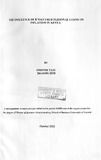| dc.description.abstract | The objective of this research is to identify how unsecured personal loans influence the inflation rates in Kenya. This study provides a comprehensive assessment of the content of the relationships and uses only a subset of data collected from the sources indicated against the samples (Tavana M, 2012, p227). The Research design I selected is Non-experimental research design. Within this approach, I focused on Relational Design in which a range of variables are measured. Relational designs are also called correlational studies. It is important to clarify here that correlation does not imply causation, but rather identifies dependence of one variable on another. Correlational designs are helpful in identifying the relation of one variable to another, and seeing the frequency of co-occurrence in two natural groups Creswell, J.W. (2012). The study involved the use of secondary data (Glass & Hopkins, 1984) these were mainly be based on information that was available in the public domain, through newspapers, publications of research establishments and regulators (Robson C,1993).
This study finds that apart from unsecured personal loans, there exists other factors like the weakening of the Kenya shilling against world major currencies in the period between January 2011 and May 2012 that also influenced inflation rate. Others were Fuel prices, Lending rates and Treasury bill rate, global economic meltdown affected Kenya through reduced foreign remittances. In August 2011, the Central Bank of Kenya through its Monetary Policy Committee finally figured out that there were twin issues to be addressed in order to manage inflation. First to contain the supply of money in circulation by raising the Central Bank Interest Rate and therefore forcing banks to increase lending rates which effectively reduced customer propensity to borrow and secondly to stabilize the Kenya shilling whose value was rapidly declining against all major currencies. The paper recognizes that inflation can be caused by other singular or multiple factors (Barrow, 2011, p215). I therefore recommend that while investigating a comprehensive list of influencers of inflation, these additional factors should be considered in a multivariate linear regression analysis. A study of this nature can further be strengthened by reviewing the effect inflation has in an economy. | en_US |



